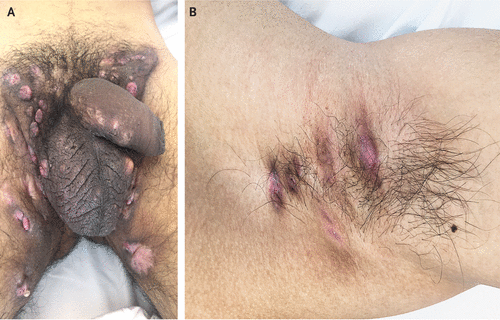
27-year-old man presented to the Center for Tropical Diseases at our hospital with a 2-year history of acne and the recurrence of multiple painful lesions in the genital and perineal areas.
He had previously been treated with multiple courses of antibiotic agents and with surgical treatments (repeated attempts to incise and drain) without resolution. Examination revealed inflamed and noninflamed nodules and scar tissue in the genitofemoral area (Panel A) and axilla (Panel B), as well as in the intergluteal area and behind the ears. A clinical diagnosis of hidradenitis suppurativa (Hurley stage II, on a scale of I to III, with higher stages indicating more abscesses and a greater affected region) was made. Hidradenitis suppurativa is a chronic, inflammatory, recurrent skin disease of the hair follicles. The cause of hidradenitis suppurativa is unclear, involving multiple causal factors, such as genetic and environmental factors. It usually manifests after puberty with painful, deep-seated, inflamed lesions in the apocrine gland–bearing areas of the body, most commonly the axillae and the inguinal and anogenital regions. Delays in diagnosis are common, because lesions are often initially mistaken for simple infections. Lesions may be slow to heal and may lead to sinus tracts and scarring. Treatment includes a combination of surgery and topical and systemic antibiotics (often doxycycline or rifampin combined with clindamycin); in severe cases, systemic immunosuppressive agents may be considered. The patient underwent 2 weeks of systemic antibiotic therapy and began a lifestyle-modification program that included smoking cessation. No improvement in his condition was noted. The patient was advised to go to a referral center for dermatology that focused on hidradenitis suppurativa. The patient was lost to follow-up.
No comments:
Post a Comment